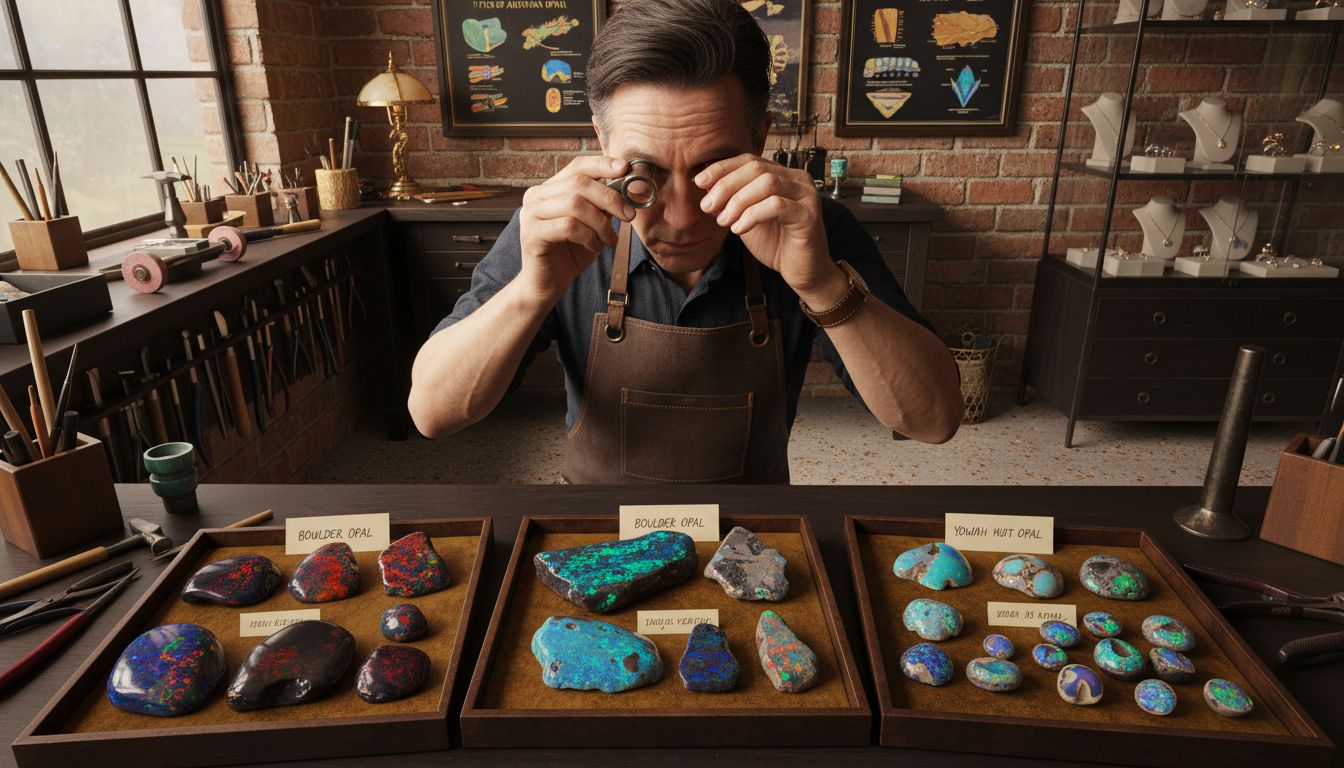Rare Opals Explained: Identifying Value and Rarity
Posted by AOD on 14th Nov 2025
Rare Opals Explained: Identifying Value and Rarity

Over 90 percent of the world’s most stunning opals come from the rugged landscapes of Australia, making these rare gemstones both a scientific marvel and a collector’s dream. Few stones match the mesmerizing play-of-color or the layered history hidden within each opal’s core. Whether you’re drawn to their fiery flashes or intrigued by their million-year origins, discovering what sets rare opals apart will deepen your appreciation for these geological wonders.
Table of Contents
- Defining Rare Opals and Their Origins
- Key Varieties of Australian Rare Opals
- Unique Physical and Optical Characteristics
- Factors Affecting Rarity and Value
- Collecting, Authenticity, and Ethical Sourcing
Key Takeaways
| Point | Details |
|---|---|
| Rarity Factors | An opal’s rarity is determined by color intensity, geological origin, size, and historical significance. Understanding these factors can aid in making informed purchasing decisions. |
| Play-of-Color | The optical phenomenon known as play-of-color is a defining feature of opals, influenced by the internal structure and arrangement of silica spheres. This uniqueness adds to their appeal and value. |
| Ethical Sourcing | Responsible collection of opals involves verifying authenticity and sourcing from ethical suppliers who prioritize sustainable mining practices. Ensuring fair compensation for miners is essential. |
| Market Determinants | The value of opals is affected by color variety, clarity, body tone, and historical context, making it important for collectors to evaluate these elements when assessing potential investments. |
Defining Rare Opals and Their Origins
Rare opals are geological treasures with extraordinary characteristics that set them apart from ordinary gemstones. Precious opals are distinguished by their remarkable optical phenomenon known as play-of-color, where vibrant flashes of rainbow-like colors dance across the stone’s surface when light interacts with its internal structure. According to Australian Museum, these unique minerals are a hydrated silica with an amorphous structure, lacking a definitive crystal form.
The origins of rare opals are deeply rooted in complex geological processes that occurred millions of years ago. Australia dominates global opal production, generating approximately 90% of the world’s supply from regions like Coober Pedy and Lightning Ridge. These locations feature specific geological conditions that enable the extraordinary formation of these gemstones. The process involves silica-rich water percolating through rock formations, gradually depositing layers of mineralized silica that create the opal’s distinctive internal structure.
Some opals transcend ordinary rarity, becoming legendary specimens that capture collectors’ imaginations. A prime example is the ‘Fire of Australia’ opal, an extraordinary gemstone weighing 998 grams and discovered in 1946 at Coober Pedy, South Australia. Wikipedia highlights how such exceptional specimens showcase the remarkable potential of Australian opal deposits.
Understanding rare opals requires appreciating their complex formation and unique characteristics. Key factors contributing to an opal’s rarity include:
- Intensity and distribution of color play
- Size of the stone
- Geological origin
- Mineral composition
- Historical significance
For gem enthusiasts seeking to explore more remarkable opal specimens, our 7 Exquisite Examples of Rare Opals for Collectors guide offers an in-depth look at some of the most extraordinary opals ever discovered.
Key Varieties of Australian Rare Opals
Australia’s diverse geological landscape produces some of the world’s most extraordinary rare opals, each with unique characteristics and formation stories. Among these remarkable varieties, certain types stand out for their exceptional beauty and scarcity. The diversity of Australian opals reflects the complex geological processes that have shaped these extraordinary gemstones over millions of years.
Boulder opals represent one of the most distinctive varieties, characterized by their striking combination of vibrant opal and host rock. Found primarily in Queensland, these opals form within ironstone, creating stunning patterns that blend the gemstone with its natural matrix. Another fascinating variety is the Yowah nut opal, which Wikipedia describes as a unique type of opal forming within ironstone concretions that remarkably resemble nuts. These opals are prized for their vibrant colors and distinctive patterns created by silica-rich water infiltrating ironstone cavities.
The primary regions of opal production in Australia include:
- Lightning Ridge (famous for black opals)
- Coober Pedy (white and crystal opals)
- Queensland (boulder and matrix opals)
- Andamooka (rainbow and crystal opals)
Collectors and enthusiasts seeking to explore the fascinating world of these gemstones can dive deeper into the nuanced characteristics of these stones in our comprehensive 7 Types of Australian Opals Every Collector Should Know guide. Each variety tells a unique geological story, representing millions of years of natural artistry preserved within these mesmerizing stones.

Unique Physical and Optical Characteristics
Opals possess an extraordinary optical phenomenon that sets them apart from all other gemstones, making them truly mesmerizing natural wonders. Play-of-color represents the most distinctive feature of these remarkable stones, creating a dynamic light show that captivates collectors and enthusiasts alike. Australian Museum explains that this unique characteristic emerges from an intricate internal structure composed of silica spheres arranged in a precise grid-like pattern.
The magical color display occurs through a complex light diffraction process. As light passes through the carefully arranged silica spheres, it splits into a stunning spectrum of colors. Interestingly, the size and arrangement of these microscopic spheres directly determine the colors observed. Larger spheres typically produce vibrant red hues, while smaller spheres generate cooler blue and green tones. This remarkable optical phenomenon means that no two opals are exactly alike, with each stone presenting its own unique color landscape.
Beyond their chromatic complexity, opals exhibit several fascinating physical characteristics:
- Amorphous mineral structure
- Hydrated composition (containing water)
- Hardness ranging from 5.5 to 6.5 on the Mohs scale
- Potential for displaying multiple color patterns
- Sensitivity to extreme temperature changes
For gem enthusiasts eager to explore the intricate world of these extraordinary stones, our 7 Types of Australian Opals Every Collector Should Know guide offers a comprehensive deep dive into the nuanced characteristics that make each opal a unique geological masterpiece.
Factors Affecting Rarity and Value
The value of rare opals is a complex interplay of multiple intricate factors that extend far beyond simple visual appeal. Australian Museum provides crucial insights, highlighting that an opal’s worth is determined by a sophisticated combination of play-of-color, pattern, body tone, and clarity. Collectors and investors must understand these nuanced elements to accurately assess an opal’s true market value and potential as a precious geological treasure.
Color spectrum and intensity represent the most critical determinants of an opal’s value. Opals displaying a full, vibrant range of colors are significantly more prized, with stones featuring dominant red hues commanding the highest prices. The body tone plays a crucial role in this valuation, with darker backgrounds creating more dramatic and intense color contrasts. This means that an opal with a rich, dark base that allows its color play to truly shine will be more valuable than a lighter, less dramatic stone.
Key factors influencing an opal’s rarity and value include:
![]()
- Intensity and diversity of color play
- Presence of rare color combinations
- Minimal internal inclusions or imperfections
- Size and weight of the stone
- Geological origin and uniqueness
- Historical or cultural significance
- Complexity of color pattern
- Optical phenomenon clarity
For those seeking to delve deeper into the fascinating world of these extraordinary gemstones, our 7 Types of Australian Opals Every Collector Should Know guide offers an illuminating exploration of the subtle nuances that distinguish truly exceptional opals from ordinary specimens.
Collecting, Authenticity, and Ethical Sourcing
Collecting rare opals requires a sophisticated understanding of authenticity, ethical sourcing, and preservation techniques that go far beyond simple acquisition. Australian Museum emphasizes the critical importance of verifying an opal’s authenticity, warning that synthetic and treated opals are prevalent in the market. Authentic opals are distinguished by their natural play-of-color and unique, unrepeatable patterns that tell a geological story millions of years in the making.
Ethical sourcing stands at the heart of responsible opal collection. This means engaging with reputable miners and dealers who prioritize sustainable mining practices, environmental preservation, and fair labor conditions. The remarkable story of the ‘Fire of Australia’ opal illustrates the deeper cultural significance of ethical collection. Wikipedia recounts how this exceptional specimen was sold to the South Australian Museum for A$500,000, deliberately preserving its cultural heritage and ensuring it remained uncut and within Australia.
Key considerations for ethical and authentic opal collection include:
- Verifying origin and mining practices
- Obtaining proper certification
- Understanding geological provenance
- Assessing natural versus synthetic stones
- Supporting responsible mining communities
- Preserving cultural and geological heritage
- Documenting stone’s complete history
- Ensuring fair compensation for miners
For collectors seeking deeper insights into responsible jewelry acquisition, our 7 Best Opal Jewelry Tips Every Collector Should Know guide provides comprehensive guidance on navigating the complex world of rare gemstone collection.
Discover Authentic Rare Opals That Reflect Their True Value
Understanding the intricate factors that define the rarity and value of opals can be challenging. You want to find genuine Australian opals with vibrant play-of-color, rich body tones, and authentic origins without the worry of synthetic or treated stones. It can be frustrating to navigate the market and ensure that every opal you collect or wear carries the history and beauty described in sources like the Australian Museum or stories of legendary stones like the Fire of Australia.
At Australian Opal Direct, we specialize in providing ethically sourced, earth-mined Australian opals from renowned regions such as Lightning Ridge, Coober Pedy, and Queensland. Each piece in our curated collections highlights the natural rarity and unique optical characteristics that define exceptional opals. Our direct relationships with miners ensure authenticity and fair pricing so you can confidently invest in rare gemstone jewelry that truly embodies millions of years of natural artistry.
Explore our exquisite selection of rings, pendants, and bracelets that celebrate the remarkable beauty described in 7 Types of Australian Opals Every Collector Should Know and deepen your understanding with 7 Exquisite Examples of Rare Opals for Collectors.

Unlock the rare beauty and inherent value of authentic Australian opals today. Visit Australian Opal Direct and find the perfect natural treasure that combines history, rarity, and stunning craftsmanship in every stone.
Frequently Asked Questions
What are the distinguishing features of rare opals?
Rare opals are characterized by their unique optical phenomenon known as play-of-color, vibrant colors, size, geological origin, and historical significance. These features set them apart from ordinary gemstones.
How does the play-of-color in opals occur?
The play-of-color in opals occurs due to an intricate internal structure composed of silica spheres arranged in a precise pattern, which diffracts light to create a spectrum of colors.
What factors determine the value of rare opals?
The value of rare opals is influenced by factors such as color spectrum and intensity, body tone, presence of rare color combinations, size, geological origin, clarity, and historical significance.
How can one ensure the authenticity of a rare opal?
To ensure authenticity, collectors should verify an opal’s origin, obtain proper certification, understand geological provenance, and assess whether stones are natural or synthetic.
Recommended
- Opal Stone 101: History, Symbolism, and Uses - Australian Opal Direct
- Opal Value Explained: A Complete Collector’s Guide - Australian Opal Direct
- 7 Exquisite Examples of Rare Opals for Collectors - Australian Opal Direct
- What Is Precious Opal? Complete Guide to Types, Value, Uses - Australian Opal Direct




